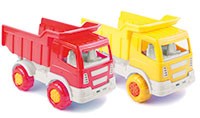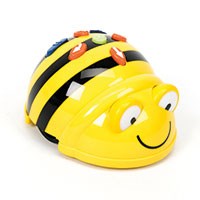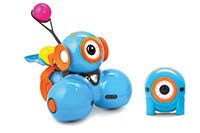Learning & Development: Computational Thinking: Part 4 - Mirror, mirror
Marc Faulder
Monday, November 27, 2017
Activities that use computational thinking, such as giving a robot very simple instructions, teach problem-solving and encourages children to take a creative approach to technology. By Marc Faulder

Download and print the PDF
IF WE ARE TO PREPARE Foundation Stage children for the next phase of their education – and the world of work – then we need to give greater heed to developing their computational thinking skills.
It is this skillset that enables children to ‘enter’ the digital world and ultimately to write code and algorithms effectively – that is, creating step-by-step processes for a computer to follow, so that it does what you want it to do.
During the course of this series, we have seen that these skills incorporate the ability to:
- spot patterns
- break down problems into smaller parts (decomposition)
- debug (identify and fix errors)
- evaluate.
What has also become apparent is the extent to which these skills mirror the Characteristics of Effective Learning (CoEL), in particular ‘Creating and thinking critically’. So, we must pay particular attention to how we scaffold activities to provide for these behaviours across the curriculum. We need to talk children through processes, breaking tasks into smaller steps and helping them find solutions to problems. Only with such support will children be able to make connections that secure their learning and enable them to progress.
Here are some examples of activities that incorporate elements of computational thinking and involve processes that mirror the programmed instructions within machines.
ACTIVITIES
Red lorry, yellow lorry
 Learning to say tongue twisters is fun, but can also incorporate elements of computational thinking. Take ‘Red lorry, yellow lorry’:
Learning to say tongue twisters is fun, but can also incorporate elements of computational thinking. Take ‘Red lorry, yellow lorry’:
Display this tongue twister as colour-coded words, as pictures of red and yellow lorries, or as a line of toy lorries and encourage the children to say it as fast as they can.
Space out the words, symbols or objects to represent pauses between the words, signalling to the children to say the tongue twister more slowly – breaking down the process and enabling the children to identify the tricky parts.
Adapt the tongue twister. For example, change it to ‘red lorry, red lorry; yellow lorry, yellow lorry’. Does this make it easier or trickier to say? How can the children adapt the sequence to make it easier or trickier to say?
 You could follow the same processes with a robot such as a Bee-Bot by trying to get it to go ‘forwards 2, backwards 2’. Can the children programme it correctly? And how will they programme it to go ‘forwards 2, backwards 2; forwards 2, backwards 2’?
You could follow the same processes with a robot such as a Bee-Bot by trying to get it to go ‘forwards 2, backwards 2’. Can the children programme it correctly? And how will they programme it to go ‘forwards 2, backwards 2; forwards 2, backwards 2’?
A birthday necklace
Challenge the children to design a necklace as a birthday present and to provide pseudocode instructions for the jeweller on how to create it. What colours or shapes will they want to repeat? Square, triangle, square, triangle? Or blue, green, blue, green?
How many times will the jeweller need to repeat the pattern? How many beads will they need?
The children could also use a robot to create the instructions. For example, with the Dash robot from MakeWonder, children can use the free app Go to make Dot display the colours of their necklace in the order they have planned. Children can then read out their instructions to a friend in the role of the jeweller. Can they follow the instructions correctly? Is the pseudocode in the correct order so that the jeweller can make the necklace as intended?
Will the instructions have to be broken down into smaller steps for the necklace to be completed?
Hit the right note
Playing music together is a great way for children to follow and give instructions.
Start by colour-coding the keys of a keyboard.
Give the children colour-coded instructions to follow so that they can play Twinkle, Twinkle, for example.
Alternatively, you could provide them with a few different sets of colour-coded instructions for them to follow and establish which set is right.
When the children are ready, they can become conductors in the orchestra. Using agreed symbols or gestures, the children can create sets of instructions for when their orchestra is to start and stop playing or when they are to play loudly or softly.
Shape-shifters
Categorise shapes by properties rather than type, using simple ‘yes or no’ flow charts that visualise the thought process – for example, ‘Does it have three corners? Yes or no.’
The children can then make up their own questions for sorting by ‘yes’ and ‘no’, such as:
- ‘Does the shape have more than four corners?’
- ‘Does it have curved edges?’
- ‘Are the edges the same length?’
The more variables, the greater the focus on the various properties of the shapes – and the more the process will reflect the operating system in a machine; for example, when a street-light sensor turns the light on, or when an oven reaches a set temperature.
Light and dark
 Children can use programmable toys such as the Dash robot (and its Dot ‘brain’) to decide when to turn the lights on, or simply by asking themselves a simple question like ‘Is it dark here?’. If the place they are in is dark, like a tent, then children can turn the robot’s light on. If they are outside in the sun, they decide not to turn the lights on.
Children can use programmable toys such as the Dash robot (and its Dot ‘brain’) to decide when to turn the lights on, or simply by asking themselves a simple question like ‘Is it dark here?’. If the place they are in is dark, like a tent, then children can turn the robot’s light on. If they are outside in the sun, they decide not to turn the lights on.
Such a simple activity makes children think about the questions that machines are programmed to check in continuous feedback loops and so helps them to understand how machines are enabling their environments.
CONCLUSION
An awareness of ‘computational thinking’ can deepen our understanding of the Characteristics of Effective Learning and help us to provide children with critical thinking and problem-solving opportunities in everyday activities.
With or without robots or other programmable devices, activities such as those outlined above help children to becoming critical thinkers and more strategic problem-solvers.
Giving children the opportunity to think about what a device or robot can do for them and how these machines use their instructions to solve problems or complete tasks empowers children to be creative in their thinking skills and allows them to be creators – not just consumers of technology.
Such experiences also ease children’s transition to Key Stage 1, which has integrated computational thinking into its curriculum – and ultimately prepares them for a world of work in which computational thinking skills will be a requirement for many.
RESOURCES
Wonder Workshop Dash Robot, £139.52, www.robotshop.com/uk
Dash & Dot Robot and Launcher, £199.99, www.amazon.co.uk
Dash and Dot direct from MakeWonder, https://uk.makewonder.com
Get Started with Code – Teacher Guide, https://itunes.apple.com/us/book/get-started-with-code-1/id1226776727?mt=11
Further reading on Marc Faulder’s website, https://enabling-environments.co.uk/category/coding-2
Barefoot Computing, https://barefootcas.org.uk
Marc Faulder is an early years teacher at Burton Joyce Primary School, Nottingham and an Apple distinguished educator.
DEFINITIONS
Algorithm is an abstract way to represent a process or calculation, independent of implementation or platform.
Code is the actual implementation of the algorithm on a specific platform, in a specific programming language.
Pseudocode are symbols that represent actions such as forwards, backwards, left, right. This becomes an agreed symbol system that your group can use to understand instructions. They work like code.
NW SHOW 2018
Marc Faulder will be one of the expert speakers at the Nursery World Show in London on 2-3 February. In his seminar ‘Technology and the Enabling Environment’, he will be passing on best practice ideas and explaining how voice and image recording technology – from photography and video to apps and tablets – can empower children to extend, record and reflect on their learning across all areas of the curriculum.
Inspiring children to learn and develop their creativity is the focus of two seminars by past winners of the Nursery World Nursery of the Year Award.
Hayley Peacock, director of Little Barn Owls Nursery and Farm School in Horsham, West Sussex will be presenting ‘The Reggio Emilia approach: from interest to inquiry’, while Clare Crowther, co-owner of Atelier Nursery in Bath and Chippenham, will explain how to create ‘spaces of discovery’.
MASTERCLASSES
Our masterclass ‘Boys’ learning: rethinking gender and early years practice’, with Gary Wilson, will question current expectations about boys’ learning and development. And ‘How children learn: inspiring, supporting, teaching’ focuses on the unique child and the kind of curriculum and adult support that will meet their emotional and learning needs.
Keynote speaker at this masterclass is Dr Maggie Aderin-Pocock. From a modest background and diagnosed with dyslexia, Ms Aderin-Pocock went on to study at Imperial College London and become the BBC’s ‘face of space’.
For the full programme, see: www.nurseryworldshow.com




